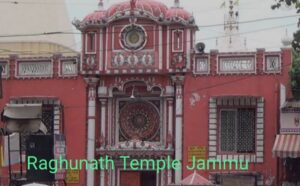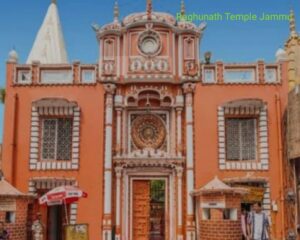Nestled in the heart of Raghunath Temple Jammu, stands as one of the largest and most significant temples in Northern India. Dedicated to Lord Rama, this temple is not only a beacon of religious faith but also a monumental symbol of Jammu’s rich cultural heritage. The temple’s sprawling complex, with its impressive architecture and deep spiritual significance, makes it a must-visit for pilgrims and tourists alike.

1.Raghunath Temple Jammu: Historical Background
The origins of Raghunath Temple date back to the mid-19th century. It was the visionary Maharaja Gulab Singh, the founder of the Dogra dynasty, who laid the foundation of this grand temple in 1835. The temple was completed in 1860 by his son, Maharaja Ranbir Singh, adding to its grandeur and historical importance.
Maharaja Gulab Singh’s vision was to create a place of worship that would reflect the glory of Hinduism and serve as a central hub for religious activities in the region. The temple was constructed during a time when the Dogra rulers were expanding their kingdom, and it served not only as a spiritual center but also as a testament to the cultural and religious ethos of the era. The architecture and the art within the temple reflect the rich traditions of the Dogra dynasty and their devotion to Hindu deities
2.Raghunath Temple Jammu: Architectural Marvel
Raghunath Temple is an architectural wonder, with its unique blend of Mughal and Sikh styles. The temple complex consists of seven shrines, each with its own tower, symbolizing the grandeur of Hindu temple architecture. The main shrine is dedicated to Lord Rama, an incarnation of Vishnu, and is adorned with gold-plated interiors that add to its splendor.
The temple’s layout is meticulously designed, with the central sanctum being the focal point of devotion. The walls of the temple are covered with beautiful frescoes and paintings depicting scenes from the Ramayana, Mahabharata, and other Hindu scriptures. These artistic elements not only enhance the spiritual ambiance but also offer a visual treat for art lovers.
The iconography within the temple is rich and diverse, with idols of various gods and goddesses, including Lord Rama, Sita, Lakshmana, and Hanuman. The intricate carvings and the use of gold in the sanctum sanctorum highlight the temple’s architectural brilliance and the attention to detail that went into its construction.
3.Religious Significance
Raghunath Temple holds immense religious significance, particularly for devotees of Lord Rama. The temple is one of the largest in Northern India and serves as a major pilgrimage site. During festivals such as Ram Navami and Diwali, the temple becomes a hub of activity, with thousands of devotees flocking to seek blessings.
The temple’s significance is not limited to its role as a place of worship. It also plays a vital role in preserving and promoting Hindu traditions and values. The rituals and ceremonies conducted here are deeply rooted in ancient practices, and the temple serves as a center for religious learning and spiritual growth.
The presence of multiple shrines within the complex allows devotees to worship a variety of deities, making Raghunath Temple a holistic spiritual destination. The temple’s role in the worship of Lord Rama, along with its connection to other Hindu gods, underscores its importance in the religious landscape of Jammu and the broader region.

4.Cultural Impact
Raghunath Temple is not just a religious site; it is a cultural landmark that has shaped the identity of Jammu over the centuries. The temple has been a center for various cultural activities, including music, dance, and religious discourses. It has played a significant role in preserving the rich traditions of Jammu, particularly those associated with the Dogra community.
The temple’s influence extends beyond religious activities. It is a focal point for community gatherings and events, serving as a space where people from different walks of life come together to celebrate their shared heritage. The festivals celebrated at Raghunath Temple, such as Ram Navami, are major cultural events in Jammu, drawing large crowds and fostering a sense of community.
Moreover, the temple has contributed to the cultural tourism of Jammu, attracting visitors from all over the country and the world. The cultural impact of Raghunath Temple is profound, as it continues to be a symbol of Jammu’s rich history and vibrant traditions.
5.Tourist Attraction
Raghunath Temple is not only a spiritual destination but also a major tourist attraction in Jammu. Its grandeur and historical significance make it a must-visit for anyone traveling to the region. The temple’s central location in the city makes it easily accessible to tourists, and its proximity to other attractions adds to its appeal.
Visitors to Raghunath Temple can expect a serene and spiritually enriching experience. The temple complex is well-maintained, and the atmosphere is peaceful, allowing devotees and tourists to immerse themselves in prayer and meditation. The intricate architecture, coupled with the beautiful surroundings, offers a perfect setting for reflection and spiritual rejuvenation.
In addition to the temple itself, tourists can explore the bustling markets around it, where they can purchase religious artifacts, souvenirs, and traditional handicrafts. The temple’s proximity to other tourist attractions in Jammu, such as the Mubarak Mandi Palace and the Bahu Fort, makes it an integral part of any travel itinerary.
https://youtu.be/_snKRIMdQ1I?si=3gcTuGoaini6V7dR
6.Challenges and Conservation
Despite its grandeur and significance, Raghunath Temple has faced its share of challenges. In recent years, security concerns have become a major issue, particularly after the terrorist attack in 2002. The attack highlighted the vulnerability of religious sites in conflict-prone areas and underscored the need for enhanced security measures.
To address these challenges, the authorities have implemented several security and conservation initiatives. The temple complex is now under tight surveillance, with a heavy security presence to ensure the safety of devotees and tourists. Conservation efforts have also been undertaken to preserve the temple’s architectural integrity and prevent deterioration due to environmental factors.
The conservation of Raghunath Temple is crucial not only for its historical and religious value but also for its role in the cultural and spiritual life of Jammu. The temple’s preservation ensures that future generations can continue to experience its beauty and significance.
Conclusion:
Raghunath Temple stands as a testament to Jammu’s rich cultural heritage and religious devotion. Its historical significance, architectural brilliance, and deep spiritual value make it one of the most important temples in India. Whether you are a pilgrim seeking blessings or a tourist interested in history and architecture, a visit to Raghunath Temple is a journey into the heart of Jammu’s spiritual and cultural legacy.
The temple’s grandeur, coupled with its serene ambiance, offers a unique experience that leaves a lasting impression. As we continue to preserve and protect this magnificent structure, Raghunath Temple will remain a beacon of faith and culture for generations to come.
FAQ:
1.What is special about Raghunath temple Jammu?
2.Which temple in Jammu has 33 crores Devi Devta?
3.How many gods are there in Raghunath temple?
4.Which god is known as Raghunath?
5.Raghunath temple Jammu attack
6.Raghunath Temple Jammu timings
7.Raghunath Temple Jammu images
8.Raghunath temple history
9.Raghunath Temple Jammu history in hindi
10.Location of Raghunath temple in Jammu

